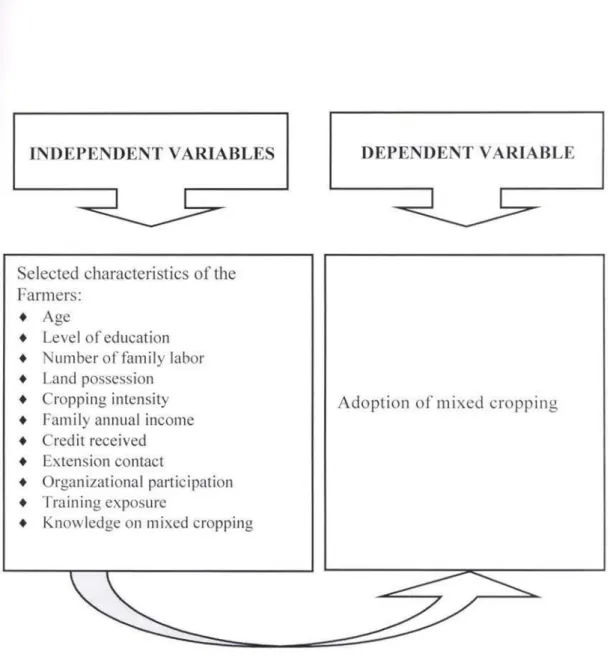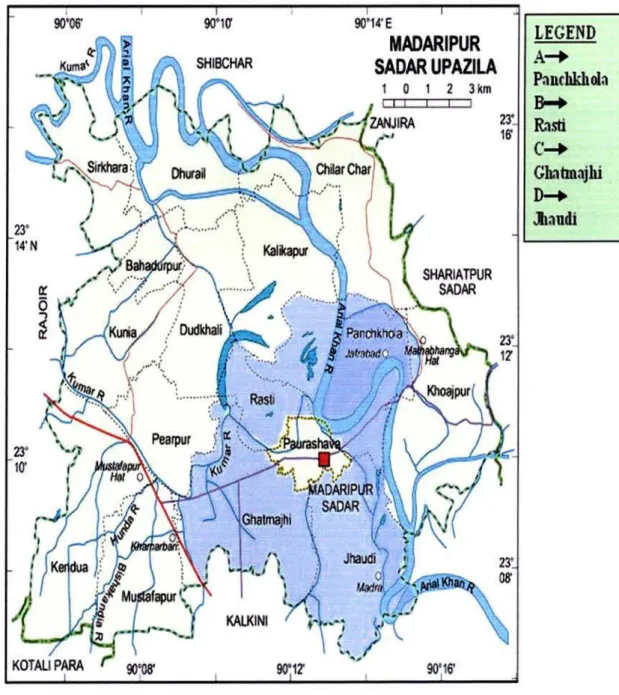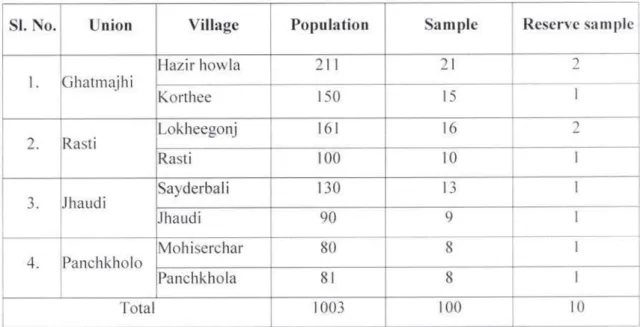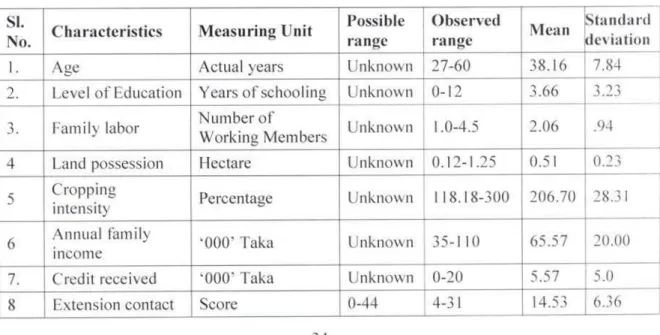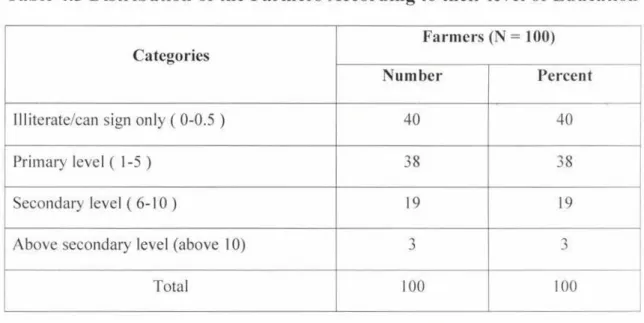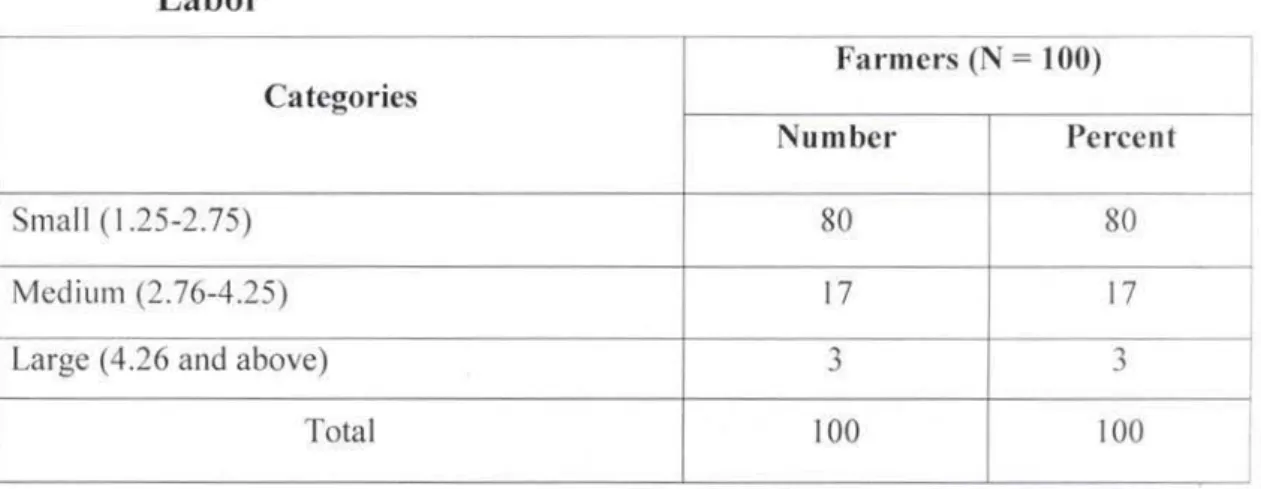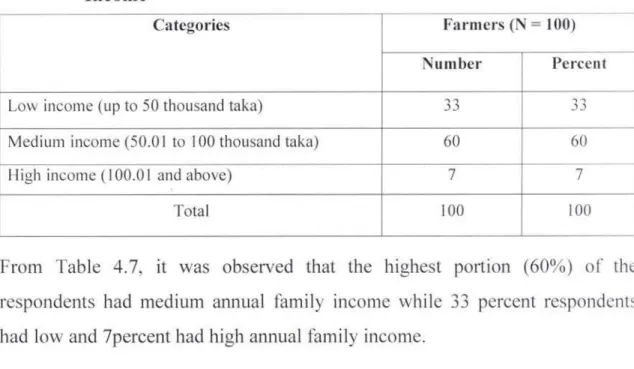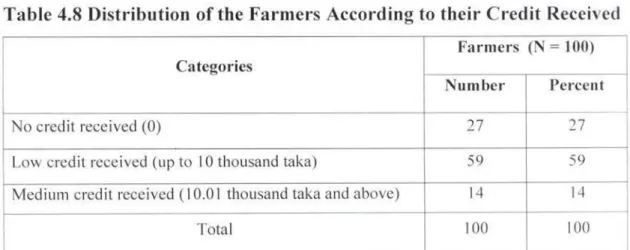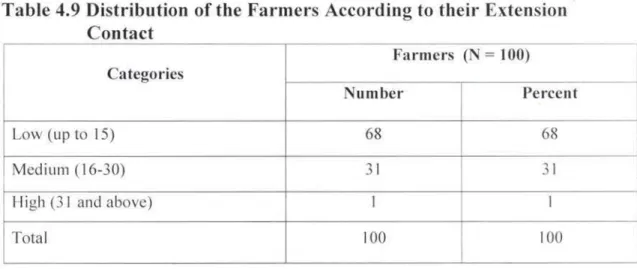DEPARTMENT OF AGRICULTURAL EXTENSION AND INFORMATION SYSTEM
ADOPTION OF MIXED CROPPING IN RABI SEASON BY THE FARMERS OF MADARIPUR SADAR UPAZILA
BY
H. M. SHAHIDUL ISLAM
Chairman
Examination Committee I Haque) (Asso. Prof. Md. Sekender Ali)
Supervisor
dul Haque)
Co-Supervisor MASTER OF SCIENCE
IN
AGRICULTURAL EXTENSION AND INFORMATION SYSTEM
SEMESTER: JULY-DECEMBER,
2007Approved by:
A Thesis
Submitted to the Faculty of Agriculture, Sher-e-Bangla Agricultural University, Dhaka,
in partial fulfillment of the requirements for the degree of
Registration No. 00459
ADOPTION OF MIXED CROPPING IN RABI SEASON BY THE FARMERS OF MADARIPUR SADAR UP AZILA
BY
H. M. SHAHIDUL ISLAM
(Associate Prof. Md. Sekender Ali) Supervisor
Dated:
Place: Dhaka, Bangladesh
~J
I further certify that such help or source of information, as has been availed of during the course of this investigation has duly been acknowledged.
This is to certify that the thesis entitled "ADOPTION OF MIXED CROPPING IN RABI SEASON BY THE FARMERS OF MADARIPUR SADAR UP AZUA" submitted to the Faculty of Agriculture, Sher-e-Bangla Agricultural University, Dhaka, in partial fulfillment of the requirements for the degree of MASTER OF SCIENCE IN AGRICULTURAL EXTENSION AND INFORMATION SYSTEM, embodies the resuJt of a piece of bona fide research work carried out by H. M. SHAHIDUL ISLAM, Registration No. 00459 under my supervision and guidance. No part of the thesis has been submitted for any other degree or diploma.
c-'IC~ <ft"Gift ~ f<t11f<tliJ161~
Sher-e-Bangla Agricultural University
Sher-e-Bangla Nagar, Dhaka-1207, Bangladesh.
o~dijt©lt~d t@
My
~J~iji~l~f ' ~id f ~ff 1~1'
The author expresses his gratitude and cordial thanks especially to Professor Md. Shadat Ulla, Department of Agricultural Extension and Information System, Sher-e-Bangla Agricultural University. The author expresses his gratitude and indebtedness to all the honorable course teachers of the The author deems it a proud privilege to express his heartfelt indebtedness, sincere appreciation and highest gratitude to co-supervisor Professor M.
Zahidul Haque, Chairman.Department of Agricultural Extension and
Information System, Sher-e-Bangla Agricultural University, Dhaka for his cordial inspiration, guidance and continuous counseling during the tenure of conducting this study.
All praises and thanks to almighty Allah, the supreme ruler of the universe who enabled the researcher to complete this study.
The author with a deep sense of respect expresses his heartfelt gratitude to his respectable supervisor Mr. Md. Sekender Ali, Associate Professor, Department of Agricultural Extension and Information System, Sher-e-Bangla Agricultural University, Dhaka for his untiring and painstaking guidance, valuable suggestions, continuous supervision and scholastic co-operation that have made it possible to complete this piece of research and reviewing the entire manuscript.
ACKNOWLEDGEMENT
II
The Author
The author desires to express his special gratitude to all the respondents of the study area for their cordial co-operation during data collection.
Last but not the least, the author expresses his heartfelt gratitude and indebtedness to Mr.Md.Jashim Uddin, Additional Agriculture Officer, Madaripur sadar upazila,Madaripur, his beloved father Mr. Md. Jalal Uddin Khan and mother Mrs. Monoara Begum, and friends for their inspiration, encouragement and blessings that enabled him to complete this research work.
PAGE
CHAPTER I
INTRODUCTION 1-8
1.1 General Background 1
1.2 Statement of the problem 3
1.3 Objectives of the Study 4
1.4 Limitation of the Study 5
1.5 Assumptions 5
1.6 Statement of Hypothesis 5
1.7 Definition of The Terms 6
CHAPTER II
REVIEW OF LITERATURE 9-20
2.1 Relationships of the Selected Characteristics of the 9 Farmers with their adoption of mixed cropping
2.1 . I Age and adoption 10
CONTENTS
viii iii vi vii ACKNOWLEDGEMENT
LIST OF CONTENTS LIST OF TABLES LIST OF FIGURES LIST OF APPENDICES ABSTRACT
PAGE
vii
LIST OF CONTENTS
IV
2.1.4 Land possession and adoption 13
2.1.5 Cropping intensity and adoption 14
2.1.6 Annual family income and adoption 15
2.1. 7 Credit received and adoption 15
2.1.8 Extension contact and adoption 15
2.1.9 Organizational participation and adoption 17
2.1. l 0 Training exposure and adoption 18
2.1.11 Knowledge and adoption 18
2.2 The Conceptual Framework of the Study 19
CHAPTER III
METHODOLOGY
21-333 .1 Design of the Study 21
3 .2 Locale of the Study 21
3 .3 Population and Sample Size of the Study 24
3.4 Selection of Independent Variable 24
3 .5 Selection of Dependent Variable 25
3.6 Measurement of Variables 25
3.6.1 Measurement of Independent Variables 25
3.6.2 Measurement of Dependent Variable 30
3.7 Measurement of Problems Faced Index (PFI) 31
in mixed cropping
CHAPTER IV
RESULTS AND DISCUSSION
34-424.1 Selected characteristics of the respondents 34
4.1. I Age 35
4.1.2 Level of education 35
4.1.3 Number of family labor 36
4.1.4 Land possession 37
4.1.5 Cropping intensity 38
4.1.6 Family annual income 38
50 49 48
48 47 46
farmers and adoption of mixed cropping
4.3. l 0 Relationship between training exposure of the farmers 51 and adoption of mixed cropping
4.3.11 Relationship between knowledge on mixed cropping of the 52 4.3.3 Relationship between number of family labor of the
farmers and adoption of mixed cropping
4.3 .4 Relationship between land possession of the farmers and adoption of mixed cropping
4.3 .5 Relationship between cropping intensity of the farmers and adoption of mixed cropping
4.3.6 Relationship between annual family income of the farmers and adoption of mixed cropping
4.3.7 Relationship between credit received of the farmers and adoption of mixed cropping
4.3.8 Relationship between extension contact of the farmers and adoption of mixed cropping
4 .3 .9 Relationship between organizational participation of the 51
4.1.7 Credit received 39
4.1.8 Extension contact 40
4.1.9 Organizational participation 40
4.1. I 0 Training exposure 41
4.1.11 Knowledge on mixed cropping 42
4.2 Adoption of mixed cropping 42
4.3 Relationship between the selected characteristics of the farmers 43 and adoption of mixed cropping
4.3.1 Relationship between age of the fanners and adoption of 45 mixed cropping
4.3.2 Relationship between level of education of the farmers and 45 adoption of mixed cropping
vi
24 34 35 36 37 37 38 39 39 40
4. l 0 Distribution of the farmers according to their organizational participation 41 4.11 Distribution of the farmers according to their training exposure 41 3.1 Distribution of Population, Sample and Reserve Sample of the study
4.1 Farmers' Personal Characteristics Profile
4.2 Distribution of the farmers according to their age
4.3 Distribution of the farmers according to their level of Education 4.4 Distribution of the farmers according to their number of family labor 4.5 Distribution of the farmers according to their land possession
4.6 Distribution of the farmers according to their cropping intensity 4.7 Distribution of the farmers according to their annual family income 4.8 Distribution of the farmers according to their credit received
4. 9 Distribution of the farmers according to their extension contact
PAGE TABLE
LIST OFT ABLES
60 63 CHAPTER VI
REFERENCES APPENDIX
56
57 58
58 59 54-59 54 54 56 56 5.1 Summary of the Findings
5. l. l Selected Characteristics of the Respondents 5.1.2 Adoption of mixed cropping
5.1.3 Relationship between dependent and independent variables of the respondent
5.1.4 Problem Faced in Adoption of Mixed Cropping 5.2 Conclusions
5.3 Recommendations
5.3.1 Recommendations for the policy implications 5.3.2 Recommendations for Future Research CHAPTER V
SUMMARY, CONCLUSIONS AND RECOMMENDATIONS
APPENDIX I PAGE Appendix-A An English Version of the Interview Schedule 63 Appendix-B Correlation Matrix of Independent and Dependent variables 69
LIST OF APPENDICES
20 22 2.1 The Conceptual Model of the Study
3.1 A Map ofMadaripur District Showing the Madaripur Sadar Upazila 3.2 A Map ofMadaripur Sadar Upazila Showing the Locale of the Study
(Union)
PAGE FIGURE
23
LIST OF FIGURES
44 53 43 4.12 Distribution of the farmers according to their knowledge 42
on mixed cropping
4.13 Distribution of the farmers according to their adoption of mixed cropping
4.14 Correlation coefficient between the selected variables 4.15 Problem Confrontation Index (PFI )score with Rank Order
viii
The main purpose of the study was to determine the extent of mixed cropping
inrabi season by the farmers of Madaripur sadar upazila and to explore the relationships between the selected characteristics of the respondents and their extent of adoption of mixed cropping in Rabi season. The study was conducted in four unions covering eight villages of Madaripur sadar upazila .Data were collected from randomly selected
I00 farmers by using a pre-tested interview
schedule during the period from November
15 to December 15, 2007. From the
study it was found that the
highest proportion (51percent) of the farmers had
low adoption of mixed cropping compared to 40 and 9 percent having mediumand high adoption of mixed cropping respectively. Pearson Product Moment Correlation(s) test was used to ascertain the relationships between the concerned dependent and independent variables of the study. Findings revealed that number of family labor, cropping
intensity,annual family income, credit received, training exposure and knowledge on mixed cropping had significant positive relationship with the adoption of mixed cropping while age, level of education, land possession, extension contact, and organization participation had no significant relationship with the adoption of mixed cropping. On the basis of descending order of Problem Faced Index (PFI) the farmers confronted the problems were "lack of extension service", "lack of inputs in time", "lack of technical knowledge", "unfavorable climate", "difficult to practice mixed cropping", "high pest attack", and "less crop production by adopting mixed cropping"
ABSTRACT
ADOPTION OF MIXEDCROPPING IN RABI SEASON BY THE
FARMERS OF MADARIPUR SADAR UPAZILA
Chapter 1
In Bangladesh, mixed cropping for pulse and oil seeds arc very important for small and medium farmers for the income and for the country as a whole. Many farmers are now practicing mixed cropping. Bangladesh has been successfully increasing the rice production over the past few years. but this has often caused a reduction in the production of other minor crops. Modern rice varieties grown with irrigation permit rice cultivation throughout the year and this remain the major driving force behind rapid growth in rice production.
The Government of Bangladesh in quest for achieving self-sufficiency in food- grain had pursued policies for over a decade that promotes expansion of cultivation of cereal crops. Other important such as roots and tubers. pulses.
oilseeds and vegetables received little or no attention and as a result the Mixed cropping in Rabi season is highly profitable. Generally pulse crops and oil seeds are the major crops grown as mixed cropping in Rabi season.
Mixed cropping increases substantial yield compared to single cropping. In Bangladesh, mixed cropping is very much essential for the farmers to increase their total income.
1.1 General Background
Mixed cropping is the judicious utilization of time and space to increase the total crop output per unit area. The process of growing and harvesting a short duration crop before canopy development and growth phase or the main crop is very much helpful for farmers Lo avert risk of crop failure. It is a very good practice to increase total crop yield balancing the nutritional requirements, higher monetary return. greater resource uti I ization and to fulfi 11 the diversified needs of the farmers.
INTROD UCTIO N
CHAPT E R I
CDP project area was concentrated in the north-west, central-west and central parts of the country. Its targeted area were confined in 125 Upazilas under 31 districts (Anonymous, 1993), comprising about one-sixth of the available land The mixed cropping programme was an integrated development programme which was a joint effort of the Government of Bangladesh. the Canadian International Development Agency (CIDA) and the Directorate General for
International Co-operation (DGl) of the Royal Netherlands Government. Four implementing agencies - the Department of Agricultural Extension (DAE). the Bangladesh Agricultural Research Institute (BART). the Bangladesh Agriculture Development Corporation (BADC) and the Department or Agricultural Marketing (DAM) and one co-ordinating agency - the Project Implementation
Unit (PIU) was involved in the implementation of Crop Diversification Programme (CDP).
production level of these crops had remained stagnant or declined. This has aggravated malnutrition and resulted in unbalanced diet of the most Bangladeshi people.This has prompted the Ministry of Agriculture of the Government of
Bangladesh to attach priority to the policy of mixed cropping during the Third and Fourth Five Year Plan with a view to increasing the production or non- cereal crops (Anonymous, 1985 and Anonymous, 1990). A comprehensive project styled mixed cropping programmed with Canadian and Dutch assistance was launched during 1990 considering the most important and realistic action programmed for implementation of this policy. The broad objectives or this programme are to increase the production of tuber, oilseed and pulse crops and to promote consumption of these crops to raise the nutritional status as a more balanced diet for the people.
3
No research has been conducted to examine the extent of farmers· adoption of mixed cropping activities. The present study was an attempt to provide more information on this subject. This research also examined the relationship between selected personal and socio-economic characteristics of farmers and their extent of adoption of mixed cropping.
1.2 Statement of the Problem
Among all other agricultural practices only mixed cropping has been taken as present research topic. Farmers have opportunity to increase the participation
level in production of tubers, oilseeds and pulses crops in mixed cropping. This participation will help to decrease the malnutrition of the country. Some farmers have realized these benefits and responded very positively to adopt this practice.
They were very much keen to get along with the practice of mixed cropping.
Some farmers in contrast, showed totally reverse attitudes. This study is.
therefore, designed to making an in-depth analysis or the extent of mixed cropping by the farmers.
- to increase the area of cultivated land for the target crops through the use of fallow land, minor irrigation and inter-cropping technique:
to increase yields of the target crops by developing new varieties and improving crop husbandry; and
to increase consumption of CDP crops through promotional campaign and market development programmed.
The CDP was marking to increase the production of selected 13 crops. The present researcher thought that more crops should be included in mixed
cropping programs. No previous research was conducted to find out the extent of adoption of mixed cropping. On the above consideration the researcher felt necessity to conduct the research entitled "Adoption of Mixed Cropping in Rabi Season by the Farmers of Madaripur Sadar Upazila".
The present study, therefore, aims to provide information regarding the following questions:
(1) What was the extent of adoption of mixed cropping by the farmers?
(2) What were the personal and socio-economic characteristics of the farmers
or
the study area?
(3) What personal and socio-economic characteristics of the farmers in the study area were related with the extent of adoption of mixed cropping by the farmers? and
( 4) What were the problems being faced by the farmers in adopting mixed cropping?
1.3 Objective of the Study
The specific objectives of the study:
I. To determine and describe some selected personal and socio-economic characteristics of the farmers, the selected characteristics were:
a) age
b) level of education c) number of family labor d) land possession
e) cropping intensity ()annual family income g) credit received
h) extension contact
i) organizational participation j) training exposure
k) knowledge on mixed cropping
2. To determine the extent of adoption of mixed cropping by the farmers 3. To determine the relationship between the selected personal and socio-
1.6 Statement of Hypothesis
A hypothesis is --a proposition which can be put to a test to determine its validity. It may seem contrary to or in accord with common sense. lt may prove to be correct or incorrect. In any event. howev er. it leads to an empirical test (Goode and Hatt. 1952)'". In order to examine the relationship bctw cen
5 1.5 Assumptions
The following assumptions were kept in mind by the researcher while undertaking the study:
1. The respondents selected for this study were competent enough to provide proper responses to the questions included in the interview schedule.
2. The views and opinions furnished by the respondents w ere the representative views and opinion of all the farmers of that area.
3. The researcher was well adjusted to the social and cultural environment or the study area. So, the data collected from the respondents were free from bias.
4. The responses furnished by the respondents were reliable. They expressed the truth about their convictions and opinions.
1.4 Limitations of the Study
The study was undertaken to understand the extent of adoption of mixed cropping by the farmers. The respondents were selected randomly from the study area. To make the study meaningful, the following limitations were taken into consideration:
l. Among 476 Upazila of Bangladesh only Madaripur Sadar Upazila under Madaripur district has been selected as study area.
2. The study was confined in four unions of Madaripur Sadar upazila.
3. Personal and socio-economic characteristics of the respondents were many but only 11 have been selected for investigation in this study.
4. In attempting to accomplish the objectives listed above, the researcher depended on information furnished by the respondents.
Level of education
Education was the production of desirable change in human behavior. that is.
change in knowledge, change in skill and change in attitude of an individual through reading, writing and observation of activities. In this study the level or education was measured on the basis of grades passed by an individual in Age
Age of the respondent was defined as the period of time in years from his birth to the time of interview. It was obtained by asking direct question.
Mixed cropping
Mixed cropping means two or more crops cultivate on a same piece of land al
the same time.
1. 7 Definition of the Terms
For clarity of understanding, certain terms used throughout the study are defined as follows:
variables. research hypotheses were formulated which stated anticipated relationship (positive or negative) between the concerned variables. However.
for statistical test, it was necessary to formulate null hypothesis. A null hypothesis states that there was no relationship between variables. If a null hypothesis was rejected on the basis of empirical test, it was then concluded that there was a relationship between the concerned variables. The following null hypotheses were formulated to explore the relationships of the variables:
"There was no significant relationship between the adoption of mixed cropping by the farmers and any of their selected characteristics"
7
Credit received
Credit received refers to the actual amount of annual credit uptake b) a
respondent and his family from Bank, NGO, Sarnabay Samity, Mone) Lender.
Businessman. relatives and other sources. It was expressed in thousand taka.
Annual family income
Annual family income refers to the actual amount or annual income or a respondent and his family earned from agricultural activities and other socially acceptable regular means, such as agricultural crops. fisheries, livestock.
business, service, etc. during a year. It was expressed in thousand taka.
Where. Net cropped area - Single cropped area -t Double cropped area + ·1 riplc cropped area
Total cropped area= Ix Single cropped area +2x Double cropped area 1 3x Triple cropped area
Net cropped area
x
100 Cropping intensity =Cropping Intensity
Cropping intensity or the respondents was expressed 111 percentage. It was
measured by using the following formula:
Total cropped area Land possession
The land possession means the cultivated area either owned by respondents family or obtained on borga I lease in term of full benefits.
Number of family labor
Number of family labor of a respondent was defined as the total number
or
working members living with the family. It includes respondents spouse.
children, father, mother, brothers and sisters and other dependents.
It was the extent of basic understanding of the farmers in different aspects
or
mixed cropping. It includes the basic understanding of cultivation procedure
or
different crops.
Knowledge on mixed cropping Training Exposure
It refers to the total number of days attended by the farmers in his life to the training on various agriculture related subject matter.
Organizational participation
Organizational participation of a farmer refers to his taking part 111 different organizations as different post bearer.
Extension Contact
This term 'extension contact' was used to refer to the degree of one's exposure to the eleven selected media of contact.
Chapter 2
Review of Literature
There were eleven independent variables of this study which included age. level of education, number of family labor, land possession, cropping intensity.
family annual income. credit received. extension contact. organizational participation, training exposure, knowledge on mixed cropping. Available literatures were reviewed to ascertain the nature of relationship of these variables of the farmers with their adoption of mixed cropping. In fact there was no literature directly related to the relationship between adoption of mixed cropping of the farmers and their selected characteristics. In this circumstance.
the literatures related to their relationship between the selected characteristics
or
the farmers and their adoption of innovation are presented below in tabular form:
2.1 Relationships of the Selected Characteristics of the Farmers with their Extent of adoption of mixed cropping
In this chapter literatures relevant to the present study were reviewed.
Information concerning the related studies was obtained by reviewing thesis.
books, publications, journals, reports and magazines and searching internet.
While searching these sources, the author could not find any study on the extent of adoption of mixed cropping by the farmers. A few research works have been done indirectly related to the study. However, the literatures have been organized into two sections and described below.
R EVI EW O F LITE RATUR E
CHAPT ER II
10
Young individuals are likely to be receptive to new ideas and things. I Ience. one would expect a negative relationship between the age of the farmers and their adoption of agricultural innovations. It was found out of l 0 studies review ed three studies show positive relationship between age and agricultural
innovations of the farmers, four studies showed negative relationship and three
Researcher Year of Independent
Dependent variable Relationship Country researcb Variables
I lossain Adoption of Farm Significant
1992 Age Bangladesh
and Crouch Practices positive
I
Adoption of Improved I
Hossain 1991 II II Bangladesh
Wheat Practices
Singh and
1990 "
Adoption of
" India
Rajendra Sugarcane Variety
Adoption of
No
Muttaleb 1995 II Improved Potato Bangladesh
Technologies
relationship
I
Adoption or I
Islam 1993 " Im proved Potato II Bangladesh
Practices
Adoption of Wheat No
Saxena et al. 1990 " India
Technology relationship
Ali 1993 " Adoption of STP Significant
Bangladesh
Technology negative
-
Haque 1993 II
Adoption of BR 14
" Bangladesh
during Boro Season
I
I laquc 1993 II
Adoption of Improved
" Bangladesh
Practices of Sugarcane
Khan 1993 " Adoption of " Bangladch
Insecticide.
2.1.1 Age and adoption
Relationships of age of the farmers with their adoption of agricultural innovations have been presented below in tabular form :
Year of Independent
Researcher Dependent variable Relationship Country
researcb variable
Muttaleb 1995 Education
Adoption of Improved Significant
Bangladesh Potato Technology positive
I
Adoption of I
Basher 1993 It Sugarcane Inter- II Bangladesh
cropping
Haque 1993 ,, Adoption of BR 14 II
Bangladesh during Boro Season
I
Haque 1993 It
Adoption of Improved
" Bangladesh
Practices of Sugarcane
Haque 1993 "
Adoption of Improved
" Bangladesh
Practices of Sugarcane
J
Khan 1993
Adoption of
" Bangladesh
" Insecticide
I
Islam 1993 II
Adoption of Improved
II Bangladesh Potato Practices
Hossain Adoption of Fann
1992 " " Bangladesh
And Crouch Practices
Adoption of
Okoro and Recommended
1992 " II igcria
Obibuaka Management of
Practice
~ Adoption of Rubber
" Indonesia
2.1.2 Level of Education and adoption
Relationships between education of the farmers and their adoption or agricultural innovations as observed in 13 studies have been presented below:
no relationship. The findings of the studies reviewed do not indicate a consistent trend between the age of the farmers and their adoption.
12
I
Researcher Year of IndependentDependent variable Relationship Country research variable
-
Muttaleb 1995 Family size
Adoption of Improved Significant
Bangladesh Potato Technologies positive
-
Okoro and Adoption of
1992 " Recommended " 1 igeria
I
Obibuaka
Management Practice
Adoption of Sugarcane No
Basher 1993 " Bangladesh
Inter-cropping relationship
No literature was found related Lo relationship between number of family labor and adoption of mixed cropping or related innovations. But there were some literatures those tried to find out the relationship between family size and adoption.
2.1.3 Family Labor and adoption
Thirteen studies showed positive relationship while only two showed no relationship. The findings, therefore, indicate a positive relationship between
education of farmers and adoption of farm innovations in general.
Hossain 1991 "
Adoption of Improved
" Bangladesh
Yheat Practice
Saxena et al. 1990 II
Adoption of Rainfed
II Ind la Yheat Technology
Adoption of STP
0
Ali 1993 " Technology of Bangladesh
relationship Sugarcane
I
Rahman 1993 II Adoption of Improved " Ban o ladcsh
Farm Practices
::)>
I
Year of Independent
I
Researcher Dependent variable Relationship Country
research variable
-
I
Adoption of
Muttaleb 1995 Farm size Improved Potato Sign i ficant
Bangladesh Technologies positive
I
Adoption of
I
Islam 1993 " Improved " Bangladesh
Potato Practice
I
Khan 1993 " Adoption of " Bangladesh
Insecticide
I
Adoption of I
Rahman 1993 II Improved Farm " Bangladesh
Practices
Hossain and Adoption of Farm
2.1.4 Land possession and adoption
Relationships between land possession and adoption of agricultural innovations as observed in 13 research studies showed that nine studies had positive relationship, one had negative and three had no relationship between land possession and adoption of innovation.
The findings do not indicate any consistent relationship between family size or the farmers and adoption of farm innovations. Therefore, these is a need to verify the relationship between family labor and adoption.
1993 " Adoption of Improved " Bangladesh
ls lam
Potato Practices
1991 "
Adoption or Improved
" Bangladesh
Hossain
Wheat Practices
I
1993 "
Adoption or Improved Significant
Bangladesh Haque
Practices of ugarcane negative
I
14
2.1.5 Cropping intensity and adoption
No literature was found related to relationship between cropping intensity and mixed cropping or related matters.
The findings indicate a general positive relationship between Land posscsson and adoption. But there were some negative and no relationship. Therefore.
there is need to verify the relationship.
Adoption of
Okoro and Recommended
1992 II " Nigeria
Obibuaka Management
Practices
Bavalatti and Adoption of Dry
Sundaraswa- 1990 II Land Farming II India
my Practices
Saxena et al. 1990 II Adoption of Wheat II India
Technology
--
-Adoption of STP
No
Ali 1993 II Technology Bangladesh
relationship
of ugarcanc
Adoption of
Basher 1993 " Sugarcane II Bangladesh
Inter-cropping Adoption
or -
I Iossa in 1991 II Improved Wheat II Hangladcvh
Practices
-- I
I laquc 1993 " Adoption of BR 14 Negative
~ during Boro Season
Adoption or
I laquc 1993 II Improved II Bangladesh
Practices of
Sugarcane
J
2.1.8 Extension contact and adoption 2.1. 7 Credit received and adoption
No I iterature was found related to relationship between credit received and mixed cropping or related matters.
The findings, therefore, indicate a consistent positive relationship or income of the farmers with adoption agricultural innovations. Farmers with higher income are likely to have better contact with change agents and also possess the ability to make investment for purchasing inputs needed for adoption
or
irnprov edpractices. This might be an explanation for the positive relationship of income with adoption of agricultural innovations.
I
Resea re her Vear of IndependentDependent variable Relationship Country research variable
Muttaleb 1995 Income
Adoption of Improved
Positive Bangladesh Potato Technology
-
Haque 1993 ti
Adoption of BR 14
II Bangladesh during Boro Season
Bhatia and Adoption Level of
1991 II " India
ingh Technology
I
Adoption of Improved No
Rahman 1993 " Bangladesh
I Farm Practices relationship
2.1.6 Annual family income and adoption
Previous findings concerning relationship of income of the farmers '' ith adoption of agricultural innovations as observed in four studies showed that three studies had positive relationship and one had no relationship.
16
Findings of the studies indicate positive relationship or extension contact '' ith adoption of agricultural innovations. Such a relationship might be due to the fact that through extension contact farmers became aware or different innovations and learnt their methods and procedure.
I
Researcher Year of Independent IDependent variable Relationship Country research variable
Extension Adoption of Improved Significant
Muualeb 1995 Bangladesh
Contact Potato Technologies positive Adoption of STP
Ali I993 " Technology of " Bangladesh
Sugarcane
Basher 1993 II
Adoption of Sugarcane
II Bangladesh I nter-cropping
~
Haque 1993 II
Adoption of BR I 4
" Bangladesh
during Boro Season
Adoption of Improved
Haque I993 II Practices of " Bangladesh
ugarcanc
Islam I993 " Adoption of Improved
II Bangladesh
Potato Practices
Rahman 1993 II
Adoption of Improved
" Bangladesh Farm Practices
I
Juliana el al. I991 "
Adoption oflPM
" India Practices
I lossain 1991 " Adoption of Improved " Bangladesh
Wheat Practices
Saxena et al. 1990 " Adoption of Rain fed " India
Wheat Technology
From the above discussion, it is evident that there was a positive relationship
Researcher Year of
I
IndependentDependent variable Relationship Country research variable
Organizational Adoption of
Significant
Basher 1993
participation Sugarcane
positive Bangladesh Inter-cropping
-"-- -
Adoption of Improved
Haque 1993 II Practices of II Bangladesh
Sugarcane
Khan 1993 " Adoption of II
Bangladesh Insecticide
Islam 1993 " Adoption of Improved " Bangladesh
Potato Practices
Rahman 1993 II Adoption of Improved II Bangladesh
Fann Practices
I lossain 1991 " Adoption of Improved II Bangladesh
Wheat Practices
Muttaleb 1995 " Adoption of Improved 0 Banu ladcsh J
Potato rechnology relalionship :::-
I-
Haque 1993 II Adoption of BRl4 Significant
Bangladesh during Boro Season negative
.
2.1.9 Organizational participation and adoption
Eight studies investigated relationships between organizational participation and adoption of technological innovations by the farmer. Six studies indicated positive relationship; only one study found no relationship and another one a negative relationship between organizational participation and the extent of adoption. Organizational participation helps an individual to go into greater depth in establishing contact with other people and change agents. It also broadens his knowledge and understandings through discussion meetings and exchange of ideas in various situations. Hence, organizational participation has a salutary effect on favorable disposing individuals towards innovations.
2.1.11 Knowledge and adoption
Findings concerning relationship of knowledge of the farmers with adoption
or
agricultural innovations as observed in three studies showed that one studies had positive relationship and two studies had no relationship.
18
The findings, therefore, indicate a consistent positive relationship or training exposure of the farmers with adoption agricultural innovations. Farmers '' ith higher training exposure are likely to have better adoption or improved practices.
Year of Independent
Researcher Dependent variable Relationship Countrv
research variable Training
Adoption of modern
ignificant
llaque 2003 maize cultivation Bangladesh
Exposure Positive
technologies
Attitude of rural women
Verma et al. 1989 Training in improved home " India Exposure
making tasks
adoption of improved
Rahman 1986 " practices in transplanted II Bangladesh
Aman rice
I lossain 1981 " Developmenl of
" Bangladesh
farming ski II
Adoption of ecological 0
Islam 2002 " Bangladesh
agricultural practices rclationsh ip
I rnpact of participation in
Basak 1997 " BRAC rural development " Bangladesh
activities
I
~2.1.10 Training exposure and adoption
Findings concerning relationship of training exposure of the farmers '' ith adoption of agricultural innovations as observed in six studies showed studies that four had positive relationship and two had no relationship.
In scicnti lie research, selection and measurement
or
variables constitute an important task. The hypothesis ofa research while constructed properly contains at least two important elements i.e. "a dependent variable" and "an independent variable''. A dependent variable is that factors which appears, disappears or varies as the research introduces, removes or varies the independent variable.An independent variable is that factor which is manipulated by the researcher in his attempt to ascertain its relationship to an observed phenomenon. In view
or
prime findings of review of literature, the researcher constructed a conceptual model or the study, which is self-explanatory and is presented in Figure 2.1.
2.2 The Conceptual Framework of the Study
The findings, therefore, indicate a consistent positive relationship or know ledge or the farmers with adoption agricultural innovations. Farmers with higher knowledge are likely to have better adoption agricultural innovations. lhis might be an explanation for the positive relationship or know ledge \\ ith adoption or agricultural innovations.
Year of Independent
Researcher Dependent variable Relationship Cou 11 try research variable
Knowledge on
Use of improved
practices in Significant
Reddy et al. 1987 package of practices in India
paddy Positive
production paddy production
- Adoption of improved 0
Rahman 1986 II Bangladesh
practices in rice rel at ionsh i p I laquc 1993 II Adoption of BR 14
II Bangladc ... 11 variety
I
20
Figure 2.1 The Conceptual Framework of the Study
Adoption of mixed cropping DEPENDENT VARIABLE
Selected characteristics of the Farmers:
+ Age
+ Level of education + umber of family labor
+ Land possession
+ Cropping intensity
+ Family annual income
+ Credit received
+ Extension contact
+ Organizational participation
+ Training exposure
+ Knowledge on mixed cropping INDEPENDENT VARIABLES
Chapter 3
3.2 Locale of the Study
The study was conducted in Madaripur Upazila under Madaripur district. The total area or Madaripur Upazila was 31-l square kilometers and the total population was 352523 (BBS. 2006). There were 38 blocks with 224 villages under 14 Unions of this Upazila. During the last three years different crops were cultivated by the farmers in all the 38 blocks. For the study at first four unions were selected randomly out of 14 unions. Finally eight villages were randomly selected from the selected four unions covering t'' o villages from ever) union in view of constraints imposed by a' ailability or time and funds. Ihcse eight villages of Madaripur Upazila was the locale of the stud). Figure 3.1 and Figure 3.2 show the map of the locale of the stud).
21
3.1 Design of the Study
The design of the study was a descriptive survey research. That is. the study was
designed to describe the mixed cropping in rabi season by the farmers
or
Madaripur Sadar Upazila and their selected personal and socio-economic characteristics. It was also designed to describe the relationship between selected characteristics of the farmers and their mixed cropping and assess the problems faced by the farmers in mixed cropping. Data were collected h~
means of conducting an interview with selected respondents. The independent variables included age, level of education, number of family labor. land possession. cropping intensity, annual family income. credit received. extension contact. organizational participation. training exposure and know ledge on mixed cropping. The dependent variable was adoption of mixed cropping in rabi season by the farmers.
METHODOLOGY
CHAPTER III
BARI SAL 90°10'
90°00' 23°
00'
GOPALGANJ
23°
10' SHARIATPUR
23°
20' 23°
20'N
FARIDPUR Bay of Bengal
23°
301
0 5 10km
5
MADARIPUR DISTRICT
90°20' E 90°10'
BANGLADESH
23' 16' R..'lsti
c~
Gbatmajhi D-+
llaudi LEGEND
A-+
Panchkhcia 8-+
23
Fig. 3.2 Map ofMadaripur sadar apazila showing study area (Union)
90•16' 9(r.12'
KALK I NI 23'
10' 23•
14'N
2 3km 90'14'E
MADARIPUR SADAR UPAZJLA
90•1(1
I
90•06'
3.4 Independent Variables
A variety or factors are likely to influence the extent or adoption of mixed
SI. No. Union Village Population Sample Reserve sample
Hazir howla 211 21
I
1 lI. Ghatmajhi -
Korthee 150 15 I
Lokheegonj 161 16 ' 1
2. Ras ti
Ras ti 100 10
I I
Sayderbali 130 13 I
3. Jhaudi
Jhaudi 90 9
I
1- -
I
Moh iserchar 80 8 I
4. Panchkholo
Panchkhola 81 8 I
I
I Total 1003 100
_L
10 -Table 3. I Distribution of the Population, Sample and Reserve Sample for the Study
3.3 Population and Sample of the Study
There were I 003 farmers in the eight villages selected for the locale
or
the studywhich was constituted the population of the study. Data for this study were collected from a sample rather than the entire population. For better representation random sampling_method was used to select the sample. A
sample population was obtained by taking I 0 percent of the estimated population of eight randomly selected villages under four randomly selected unions. Thus 100 farmers constituted the sample of the study. Further I 0 farmers were selected randomly which constituted the reserve list and those would be interviewed when farmer from the sample was not available at the time of interview. Distribution of the population, sample and reserve list is shown in Table 3.1.
Level or Education was measured on the basis or schooling yearsand one score was assigned for one year of schooling. IC a respondent passed Jina I examination of class V, his education score was taken as 5. If the respondent was educated in
25 Level of education
Age
Age or the respondents was calculated on the basis or total period
or
time from respondents' birth to the time or interview. It was obtained by asking direct question and was measured in terms or year. Since Bangladeshi rural people actually do not keep record of their birth date, age was sometimes based on arbitrary estimates.3.6 Measurement of Variables
3.6.1 Measurement Independent Variables
Eleven personal and socio-economic characteristics of the farmers were selected as independent variables or this study. Procedures used in measuring the eleven characteristics arc described below:
3.5 Dependent Variable
Adoption of mixed cropping by the farmers was the only dependent variable
or
study.
faculty members, experts and research fellows in agricultural extension education and related fields. He also carefully observed the personal and socio- economic characteristics of the farmers and their work passions. Availability
or
time, money and other resources were kept in view in selecting the variables.
Considering the various relevant factors the researcher ultimately selected eleven personal and socio-economic characteristics of the farmers us independent variables of the study. The variables included: age, level
or
education. number of family labor, land possession, cropping intensity, annual family income, credit received, extension contact, organizational participation.
training exposure and knowledge on mixed cropping.
Land possession
Data obtained in response to item no. 5
or
the interview schedule formed the basis for determining the land possession of the respondent family. It \\:.1S measured on the basis of the actual amountor
land he and his Cami ly present I~owned under cultivation. The land possession was measured in terms of' hectare by using the following formula:
Land possession= A+ B + C+ 112 (C +D)+ E
18 years and above 1.00
The scores for all the members were added together to obtain the lbmil) labor score.
Score 0.00
0.25 0.50 Age of family members
Up to 6 years 7 to 12 years
13 to 17 years
Number of family labor
Number or family labor of a respondent was measured on the basis or number of working member living with the family. It includes the respondent himself/herself his/her spouse, children, father. mother, brothers and sisters.
grandfather, grandmother and other dependents. Score
or
the number of farnil, labor was assigned as follows:Madrasa and the level of his education was equal lo the level or class II I. his education score was taken as 3. For illiterate respondents who had no formal schooling, the education score was taken as zero (0). Respondents who can sign only were given score as 0.5. Education score or a respondent was determined from his response to ltem no. 2 of the interview schedule.
Credit received
Credit received of a respondent was measured in thousand taka on the basis
or
the amount of receiving credit in a year from bank. NGO. sarnabay samity.
money lender, businessman. relatives and other sources. Data obtained in
27 Annual family income
lncome of a respondent was measured 111 thousand iaka on the basis
or
totalyearly earnings from agriculture and other sources of his family. Data obtained in response of item no. 6 of the interview schedule were used lo determine the annual family income of the respondent. The method or ascertaining income from agriculture and other sources like service. business etc. were determined by asking direct question. Yearly earnings of all the members of the fomil~ from
agriculture and other sourccs w ere added together to calculate the actual amount of family annual income of the respondent. A score of I (one) was assigned for the income or one thousand taka.
Where, Total cropped area= Ix Single cropped area+ 2x Double cropped area + Jx'Triple cropped area
Net cropped area= ingle cropped area+ Double cropped area t- ·1 riplc cropped area
Net cropped area
x
100Cropping intensity=
Cropping intensity
Cropping intensity of the respondents was expressed m percentage. It was measured by using the following formula:
Total cropped area C = Land taken from other as borga
D =Land given from other as borga and E
=
Land taken from other as leaseOrganizational participation
Organizational participation of a respondent was measured by the nature and duration or participation in 3 selected organizations. The score of organizational participation for a particular organization was computed in the following manner:
Organizational participation score=
I
(N X D)Where.
N =Nature of participation, D
=
Duration.Thus extension contact score of a respondent could range frornO' to ·4 ... r, while
·o·
(zero) indicating no extension contact and ·44· indicating high extension contact.Extension contact
Extension contact refers to a farmer's nature of contact with eleven selected extension media. The respondents were asked to mention the nature of contacts with eleven selected media with five alternative responses as 'rcgularly '.
'often'. 'occasionally', 'rarely' and ·not at air and scores were assigned to those alternative responses as 4,3,2, I and 0 respectively. Logical frequencies
or
contact were considered for each of the alternative responses for each
